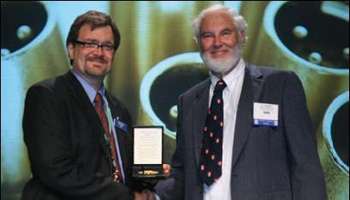John G. McKnight

John G. (Jay) McKnight (born February 11, 1931) is a co-founder of Magnetic Reference Laboratory (MRL) in San Jose (formerly Mountain View), California, where he was engineering vice-president from 1972 to 1975, and has been the president since 1975. He also develops new products and directs engineering at MRL.
Biography
McKnight was born in Seattle, Washington. He received his B.S. in electrical engineering from Stanford University in 1952, and worked for Ampex Corp. from 1952 through 1972, except for the years 1953 through 1956 when he served in the U.S. Army, at the Armed Forces Radio Service (AFRS) in New York City, where he also worked at the Gotham Recording studio. At Ampex, he served in the magnetic recording research group, the stereo tape division, and the professional audio division. In addition to research, he also worked on the design of the CinemaScope reproducer system; the Models 350, PR-10, and MR-70; improvements in the high-speed duplication system and operating procedures at the Ampex Music (Stereo Tape) Division; and he developed the "Ampex Master Equalization" (AME). He has published more than 70 technical papers,[1] mostly in the Journal of the Audio Engineering Society (AES), on the theory and practice of magnetic recording, and on audio engineering. He received the Audio Engineering Society's Publication Award in 1982.
From 1972 to 1974 he also was a consultant to Scully/Metrotech in Mountain View, California, and to MCI in Ft. Lauderdale, Florida, on audio systems and magnetic recording. In 1973 and 1974 he was a member of Judge Sirica's "Advisory Panel on White House Tapes" (“The Watergate Tapes”), and in 1977...79 a member of the Committee on Evaluation of Sound Spectrograms of the United States National Academy of Sciences.
Jay and his wife Brigitte have four adult sons, Ken, Jeff, Rick, and Mike.
His hobbies include hiking, camping, and 4-wheel driving; programming in the Forth computer language; and playing viola in several amateur string quartets, in community orchestras, and in the orchestras of two Gilbert & Sullivan opera companies.[2]
Milestones
While McKnight has had an extensive audio career, there a few milestones that are worth singling out, namely his work on the custom console used by Les Paul with his 8-track Ampex machine in 1956 and his work on the Advisory Panel for the Nixon tapes.
Les Paul
When Les Paul got the Ampex 8-track machine, he realized that he would need a custom built console to work with the new multitrack recorder. He hired Rein Narma (chief engineer at Fairchild Recording Equipment) to do the job. McKnight had worked with Narma at Gotham Audio in New York and wound up helping with some of the design and layout, as well as installation.
Nixon Tapes
Although the investigation into the Nixon tapes has been well documented, McKnight has some interesting personal insight, having been on the Advisory Panel:
The first purpose, I recall, was to try to make the tapes that they found more understandable. But before very long they found out that there was an 18-minute gap in one of the tapes, and that's what the panel focused on. What we were able to do was verify which machines had made the recordings and which had been used to erase the recordings. The recordings were made on a Sony Model 800B, a little consumer kind of machine... it ran 15/16ths inches per second, and Nixon's staff had attached a sound-activated start and stop feature. And the Secret Service came through every evening and put new roll of tape on it if it had run out of tape. The machine that was used in the erasure was an Uher 5000, a commonly used German dictation recorder. What we could establish was that you can hear the clicks where the machine's been put in and out of recording mode. And we could establish that the clicks were in fact from going in and out of recording. We could say that the likelihood that it was done accidentally was incredibly remote. The erasing machine was put in and out of recording mode six times, so judge for yourself how likely that was to have been accidental.[3]
Committees
- Member of the Audio Engineering Society Journal Review Board for the years 1960...2007
- Governor of the AES four times (1962...1964, 1971...1973, 1976...1977, and 1980...1982)
- Chairman of the Standards Committee (1971...1974)
- Chairman of the Publications Policy Committee (1977...1978)
- Chairman of the Historical Committee (1999...2006)
- Chair Emeritus of Historical Committee[4]
- Member of standards committees on audio engineering and magnetic recording of the AES, ANSI, CCIR, EIA, IEC, IEEE, NAB, RIAA, and SMPTE
- Presently Chair of the AES Standards Committee Working Group on Analog Recording, SC-03-01.
- Senior member of the IEEE, was a member of the “IRE (IEEE) Professional Group on Audio” when it existed (about 1953...1970)
- Member of the IEEE Magnetics Society since about 1968.
Awards and honors
- 1960 — Fellow of the AES[5]
- 1971 — AES Award
- 1978 — President of the AES
- 1979 — Honorary Member of the AES
- 1990 — AES Board of Governors Award
- 2008 — Distinguished Service Medal Award, for extraordinary service to the society and contributions to the advancement of knowledge in magnetic recording over a period of more than 50 years
References
- ↑ Papers Written or Edited by John G. McKnight
- ↑ Ampex Mailing List Biographies
- ↑ Behind The Gear: Jay McKnight of Magnetic Reference Laboratory", by Alex Kostelnik, from Tape Op, Nr 52 (2006 Mar/Apr)
- ↑ AESHC Officers
- ↑ AES Past Awards Recipients
External links
- Magnetic Reference Laboratory
- Magnetic Reference Laboratory and the State of Reproducer Calibration
- Jay McKnight at Ampex, the rest of Alex Kostelnik's interview that was not used in the Tape Op article.
|